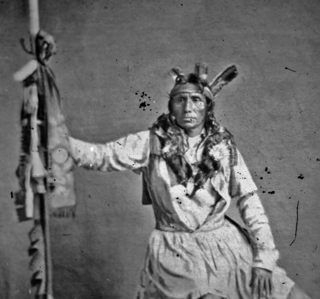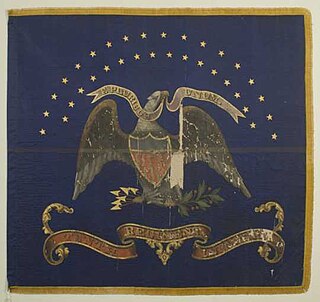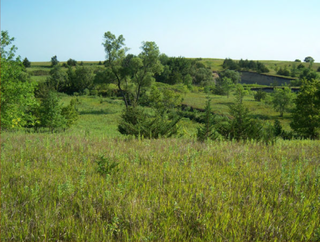
Meeker County is a county in the U.S. state of Minnesota. As of the 2020 census, the population was 23,400. Its county seat is Litchfield.

The Battle of Fort Ridgely was an early battle in the Dakota War of 1862. As the closest U.S. military post to the Lower Sioux Agency, the lightly fortified Fort Ridgely quickly became both a destination for refugees and a target of Dakota warbands after the attack at the Lower Sioux Agency. It came under attack by the Dakota on August 20, 1862, two days after a company of soldiers responding from the fort to the attack on the Lower Sioux Agency had been ambushed and defeated at the Battle of Redwood Ferry. The Dakota besieged and partially destroyed the fort, but were unable to storm it before the August 27 arrival of Colonel Henry Sibley with 1,400 men from Fort Snelling prompted them to retreat.

Little Crow III was a Mdewakanton Dakota chief who led a faction of the Dakota in a five-week war against the United States in 1862.

The Lower Sioux Agency, or Redwood Agency, was the federal administrative center for the Lower Sioux Indian Reservation in what became Redwood County, Minnesota, United States. It was the site of the Battle of Lower Sioux Agency on August 18, 1862, the first organized battle of the Dakota War of 1862.

The Battle of Redwood Ferry took place on August 18, 1862, on the first day of the Dakota War of 1862. A United States Army company responding to the Dakota attack at the Lower Sioux Agency from Fort Ridgeley was ambushed and defeated at Redwood Ferry.

The Forest City Stockade was built in central Minnesota to defend settlers in the area from Indian attacks. It became famous during the Dakota War of 1862, when it was besieged by the Dakota as part of Little Crow's attack on Forest City. In the 21st century, the rebuilt stockade functions as a tourist attraction and memorial to the battle. Visitors to the site can visit a rebuilt stockade and see volunteers in 19th-century dress illustrate period life and activities. A threshing bee takes place across the road in August. The site of the stockade is between Litchfield and Forest City near Minnesota State Highway 24.

The 5th Minnesota Infantry Regiment was a Minnesota USV infantry regiment that served in the Union Army in the Western Theater of the American Civil War and Dakota War of 1862. The regiment distinguished itself serving in its home state and the south, particularly at the Battles of Fort Ridgely, Corinth and Nashville.

The 10th Minnesota Infantry Regiment was a Minnesota USV infantry regiment that served in the Union Army during the American Civil War.

Fort Abercrombie, in North Dakota, was a United States Army fort established by authority of an Act of Congress, March 3, 1857. The act allocated twenty-five square miles of land on the Red River of the North in Dakota Territory to be used for a military outpost, but the exact location was left to the discretion of Lieutenant Colonel John J. Abercrombie. The fort was constructed in the year 1858. It was the first permanent military installation in what became North Dakota, and is thus known as "The Gateway to the Dakotas". Abercrombie selected a site right on the river. Spring flooding was a problem and the fort was abandoned. However, in 1860 the Army returned, moving the fort to higher ground.

The Battle of Wood Lake occurred on September 23, 1862, and was the final battle in the Dakota War of 1862. The two-hour battle, which actually took place at nearby Lone Tree Lake, was a decisive victory for the U.S. forces led by Colonel Henry Hastings Sibley. With heavy casualties inflicted on the Dakota forces led by Chief Little Crow, the "hostile" Dakota warriors dispersed. Little Crow and 150 followers fled for the northern plains, while other Mdewakantons quietly joined the "friendly" Dakota camp started by the Sisseton and Wahpeton bands, which would soon become known as Camp Release.

The Battle of Birch Coulee occurred on September 2–3, 1862, and resulted in the heaviest casualties suffered by U.S. forces during the Dakota War of 1862. The battle occurred after a group of Dakota warriors followed a U.S. burial expedition, including volunteer infantry, mounted guards and civilians, to an exposed plain where they were setting up camp. That night, 200 Dakota soldiers surrounded the camp and ambushed the Birch Coulee campsite in the early morning, commencing a siege that lasted for over 30 hours, until the arrival of reinforcements and artillery led by Colonel Henry Hastings Sibley.

The Attack at the Lower Sioux Agency was the first organized attack led by Dakota leader Little Crow in Minnesota on August 18, 1862, and is considered the initial engagement of the Dakota War of 1862. It resulted in 13 settler deaths, with seven more killed while fleeing the agency for Fort Ridgely.

The Battles of New Ulm, also known as the New Ulm Massacre, were two battles in August 1862 between Dakota men and European settlers and militia in New Ulm, Minnesota early in the Dakota War of 1862. Dakota forces attacked New Ulm on August 19 and again on August 23, destroying much of the town but failing to fully capture it. After the second attack, New Ulm was evacuated.

The Dakota War of 1862, also known as the Sioux Uprising, the Dakota Uprising, the Sioux Outbreak of 1862, the Dakota Conflict, or Little Crow's War, was an armed conflict between the United States and several eastern bands of Dakota collectively known as the Santee Sioux. It began on August 18, 1862, when the Dakota, who were facing starvation and displacement, attacked white settlements at the Lower Sioux Agency along the Minnesota River valley in southwest Minnesota. The war lasted for five weeks and resulted in the deaths of hundreds of settlers and the displacement of thousands more. In the aftermath, the Dakota people were exiled from their homelands, forcibly sent to reservations in the Dakotas and Nebraska, and the State of Minnesota confiscated and sold all their remaining land in the state. The war also ended with the largest mass execution in United States history with the hanging of 38 Dakota men.
The 1st Dakota Cavalry was a Union battalion of two companies raised in the Dakota Territory during the American Civil War. They were deployed along the frontier, primarily to protect the settlers during the Dakota War of 1862.
The Department of the Northwest was an U.S. Army Department created on September 6, 1862, to put down the Sioux uprising in Minnesota. Major General John Pope was made commander of the Department. At the end of the Civil War the Department was redesignated the Department of Dakota.
Acton is an unincorporated community in Acton Township, Meeker County, Minnesota, United States, near Grove City and Litchfield. The community is located along Meeker County Road 23 near State Highway 4. County Road 32 is also in the immediate area.

The Battle of Acton was fought between the United States Army and the warrior bands of Chief Little Crow and Walker Among Stones during the Dakota War of 1862. Following the defeats at Fort Ridgley and New Ulm, Chief Little Crow led an incursion north out of the Minnesota River Valley into central Minnesota. Company B of the Tenth Minnesota Infantry Regiment commanded by Captain Richard Strout was sent to protect the citizens of Meeker County.

The Attack on Hutchinson occurred on September 4, 1862 during the Dakota War of 1862 as a part of Chief Little Crow's incursion into the Big Woods area of Minnesota. On September 3, Little Crow encountered Captain Strout's Company B, 10th Minnesota Infantry Regiment near Acton and chased it to the stockade of the town of Hutchinson. On September 4 Little Crow attacked with 200 warriors and destroyed most of the buildings outside of the stockade. Small firefights broke out between the Hutchinson Home Guard and Sioux warriors, but the Dakota failed to breach the town's defenses. Little Crow's men subsequently retreated, bringing as much loot as they could carry.

Shakopee III was a Mdewakanton Dakota chief who was involved at the start of the Dakota War of 1862. Born Eatoka, which means "Another Language," he became known as Shakpedan or Little Six after the death of his father in 1860.



















